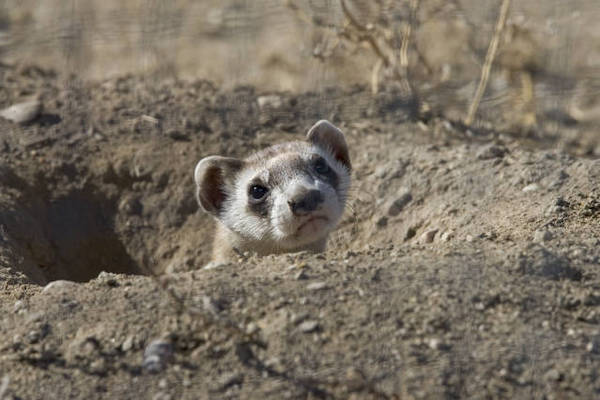SEJournal Online is the digital news magazine of the Society of Environmental Journalists. Learn more about SEJournal Online, including submission, subscription and advertising information.
 |
| The U. S. endangered species list includes nearly 1,300 species, plus another 400-plus that are currently threatened. Above, the endangered black-footed ferret. Photo: U.S. Fish and Wildlife Service/Ryan Hagerty via Flickr Creative Commons (CC BY 2.0). |
Reporter’s Toolbox: When Sizing Up Threats to Biodiversity, Databases Can Help
By Joseph A. Davis
With the COP15 Biodiversity Treaty talks underway in Montreal through Dec. 19, a good many environmental journalists are writing about biodiversity. Fortunately, there are a number of databases journalists can tap into that even if they don’t directly save species can at least help count them.
The work often starts with lists. There is supposed to be a list, right? Perhaps one of the best known in the United States is the endangered species list. It’s an outgrowth of the U.S. Endangered Species Act of 1973 and is mostly maintained by the U.S. Fish and Wildlife Service (with some help from the National Marine Fisheries Service).
The U.S. endangered list includes roughly
1,271 species, as well as another 404 that
fit into the less serious “threatened” category.
The endangered list includes roughly 1,271 species, as well as another 404 that fit into the less serious “threatened” category (here’s a summary). That’s just those species that occur in the United States. The list also includes another 696 species not found in the United States but which the country has declared endangered or threatened.
A good place to access the list is the Environmental Conservation Online System, or ECOS. Two nice things about the ECOS listings: first, it provides a mapped presentation of the species range, and second, it gives you the ability to click down to the database for the record of biological info about each species.
Red List, Catalogue of Life and more
In practical terms, environmental journalists should also be aware of the International Union for Conservation of Nature’s Red List, which will certainly be mentioned in Montreal. The IUCN, composed of both governmental organizations and NGOs, keeps track of the most threatened species worldwide. There are currently more than 40,000.
Another database to know about is that of the Global Biodiversity Information Facility. This multinational group aims for an open-access network of biodiversity information. It is global in scope and oriented toward research.
Your hunger for biodiversity data may ultimately bring you to the Catalogue of Life. It is the most ambitious database in scope and focuses on taxonomic names and organizing species along evolutionary lines.
For more, you can find a list of biodiversity databases. Or if you are a glutton for this stuff, you may want to visit a university library and browse through the Biodiversity Data Journal, an open-access academic journal that will take you deeper. Consider the authors' sources.
The bigger picture
While we’re on the topic, just how big would a database of all species be? Honestly, Toolbox doesn’t really know.
Looked at another way, you might be asking how many species there are all told. That would mean knowing what is a species, an inquiry that could be discussed for years. It’s not really enough to say it’s something that reproduces sexually — since many organisms don’t.
It’s important to realize how huge the catalog of life in nature actually is: clams, flatworms, fungi, viruses and more. It’s complex.
But scientists are game enough to estimate the number. An article in the journal PLoS Biology took a shot at it in 2007 and guessed the approximate number of eukaryotic species (organisms whose cells have nuclei) to be 8.7 million. Yet, suggested the same authors, of the species that exist we only know a small fraction.
And want to really boggle the mind? Recall that 99.9 percent of the species that have ever existed are today extinct.
[Editor’s Note: For more on biodiversity, check out our recent Tipsheet on the Montreal meeting and watch a 2021 SEJ webinar on covering biodiversity. To help localize your biodiversity reporting, see ToolBoxes on a bird migration mapper and a Western wildlife migration tracker, and Tipsheets on pollinator gardens and birding walks. Also check out Inside Story Q&As on projects involving free markets and endangered species and on the threat to biodiversity from tree farms, Features about the extinction threat to an iconic grassland bird and rights of nature, and FEJ StoryLogs on reporting projects about eating biodiverse rainforest foods and tracking illegal foresting. In addition, we’ve got BookShelf reviews of volumes on saving the U.S.’s most biodiverse river system and on conflicts in managing species. Finally, keep on biodiversity coverage with our new biodiversity “Topics on the Beat” page and get the latest headlines and more stories from our biodiversity and wildlife indexes.]
Joseph A. Davis is a freelance writer/editor in Washington, D.C. who has been writing about the environment since 1976. He writes SEJournal Online's TipSheet, Reporter's Toolbox and Issue Backgrounder, and curates SEJ's weekday news headlines service EJToday and @EJTodayNews. Davis also directs SEJ's Freedom of Information Project and writes the WatchDog opinion column.
* From the weekly news magazine SEJournal Online, Vol. 7, No. 45. Content from each new issue of SEJournal Online is available to the public via the SEJournal Online main page. Subscribe to the e-newsletter here. And see past issues of the SEJournal archived here.













 Advertisement
Advertisement 



